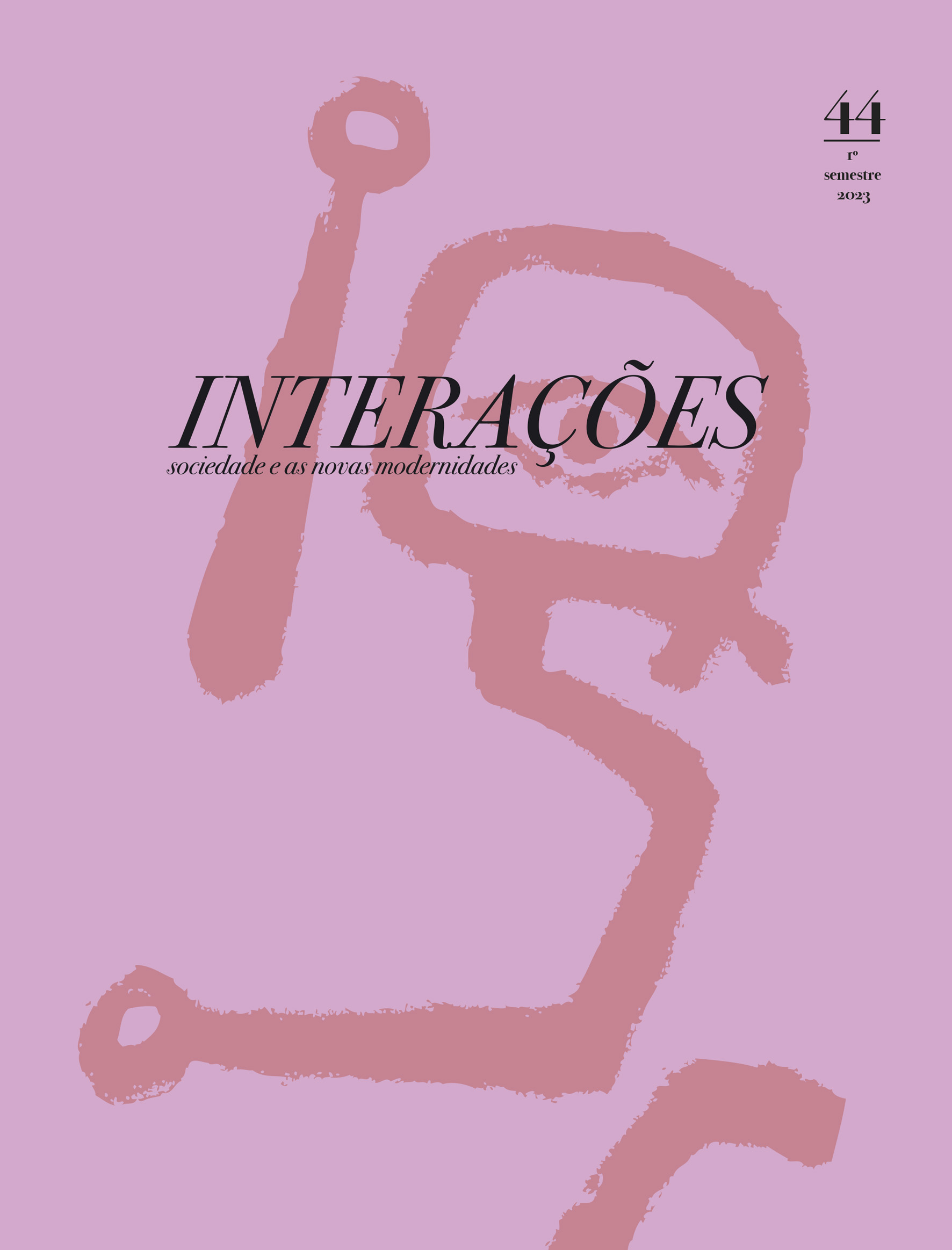Comunicação Interna e Cultura Organizacional
Revisão de Literatura
DOI:
https://doi.org/10.31211/interacoes.n44.2023.a2Keywords:
Internal communication, Organizational communication, Organizational culture, Literature reviewAbstract
Internal Communication and Organizational Culture: Literature Review
The aim of this study is based on the achievements of a systematic review of studies that investigated the relationship between internal communication and organizational culture. Internal communication concerns the communication produced and established between employees of an organization. In turn, an organizational culture refers to the identity of the company that is exposed by the way it establishes its business and treats its employees and stakeholders. The sample is made up of empirical studies, people with different positions and levels of education and even companies. Data collection was based on the analysis of case studies, questionnaires and interviews. The studies centered on the existing types of communication, with a focus on internal communication and its articulation with the organizational culture. The results of this analysis revealed that internal communication is directly related to organizational culture and that the best communication strategy is to transform employees into ambassadors for the organization. The main limitations of the study focus on the limited time space, between 2017 and 2022, and sample size. The value of this study is translated into a better perception of the investigated constructs and their relationship.
Downloads
References
Balkin, J. M. (1999). How mass media simulate political transparency. Cultural Values, 3(4), 393–413. https://doi.org/10.1080/14797589909367175
Barale, R. F., & Santos, B. R. (2017). Cultura organizacional: Revisão sistemática da literatura. Revista Psicologia Organizações e Trabalho, 17(2), 129–136. https://doi.org/10.17652/rpot/2017.2.12854
Barsade, S., & Knight, A. P. (2015). Group affect. Annual Review of Organizational Psychology and Organizational Behavior, 2(14), 1–26. https://doi.org/10.1146/annurev-orgpsych-032414-111316
Berger, B. (2015, February 5). Read My Lips: Leaders, supervisors, and culture are the foundations of strategic employee communications | Institute for public relations. Institute for Public Relations. https://instituteforpr.org/read-lips-leaders-supervisors-culture-foundations-strategic-employee-communications/
Curvello, J. J. A. (2012). Comunicação interna e cultura organizacional. Casa das Musas.
Denison, D. R. (1997). Corporate culture and organizational effectiveness. Aviat, Inc.
Elias, N., & Kilminster, R. (2011). The symbol theory. University College Dublin Press.
Hofstede, G. (2001). Culture’s consequences: Comparing values, Behaviors, Institutions, and Organizations across Nations (2nd ed.). Sage.
Hooks, J., Coy, D., & Davey, H. (2002). The information gap in annual reports. Accounting, Auditing & Accountability Journal, 15(4), 501–522. https://doi.org/10.1108/09513570210440577
Jiang, H., & Men, R. L. (2017). Creating an engaged workforce. Communication Research, 44(2), 225–243. https://doi.org/10.1177/0093650215613137
Kunsch, M. M. K. (2016). Comunicação organizacional estratégica. Summus Editorial.
Marques, R. (2004). Comunicação Interna. Editora Abril.
Martin, J., & Frost, P. (2001). Jogos de guerra da cultura organizacional: A luta pelo domínio intelectual. In S. Clegg, C. Hardy & W. Nord, Handbook de estudos organizacionais. Atlas.
Mayfield, M., & Mayfield, J. (2017). Leader Talk and the Creative Spark. International Journal of Business Communication, 54(2), 210–225. https://doi.org/10.1177/2329488416687057
Men, L. R., & Stacks, D. (2014). The Effects of Authentic Leadership on Strategic Internal Communication and Employee-Organization Relationships. Journal of Public Relations Research, 26(4), 301–324. https://doi.org/10.1080/1062726x.2014.908720
Men, L. R., & Yue, C. A. (2019). Creating a positive emotional culture: Effect of internal communication and impact on employee supportive behaviors. Public Relations Review, 45(3), 101764. https://doi.org/10.1016/j.pubrev.2019.03.001
Menezes, E. A. C., Guimarães, T. de A., & Bido, D. de S. (2011). Dimensões da aprendizagem em organizações: validação do Dimensions of the Learning Organization Questionnaire (DLOQ) no contexto brasileiro. RAM. Revista de Administração Mackenzie, 12(2), 4–29. https://doi.org/10.1590/s1678-69712011000200002
Pérez Martínez, A. (2009). Cultura organizacional: Algunas reflexiones a la luz de los nuevos retos. Revista Venezolana de Gerencia, 14(46). https://doi.org/10.31876/revista.v14i46.10529
Rawlins, B. (2008). Give the Emperor a Mirror: Toward Developing a Stakeholder Measurement of Organizational Transparency. Journal of Public Relations Research, 21(1), 71–99. https://doi.org/10.1080/10627260802153421
Ruão, T. (2004). O estado da arte em Comunicação Organizacional. 1900 – 2000: um século de investigação.
Ruão, T. (2016). A organização comunicativa: teoria e prática em Comunicação Organizacional. Centro de Estudos de Comunicação e Sociedade.
Santos, C. J., Neves, F. T., Balieiro, R. T., & Denardi, T. C. (2019). A influência da comunicação na cultura organizacional: revisão sistemática da literatura. Revista EDaPECI, 18(3), 6–18. https://doi.org/10.29276/redapeci.2018.18.310082.6-18
Santos, J. V. dos, & Gonçalves, G. (2010). A cultura organizacional: O impacto visível de uma dimensão invisível. Psico, 41(3). https://revistaseletronicas.pucrs.br/ojs/index.php/revistapsico/article/view/8167
Schein, E. H. (2017). Organizational Culture and Leadership. John Wiley & Sons.
Sebastião, S. P., Zulato, G., & Trindade, A. D. (2017). Internal communication and organisational culture: The management interplay in the view of the Portuguese communication consultant. Public Relations Review, 43(4), 863–871. https://doi.org/10.1016/j.pubrev.2017.05.006
Smircich, L. (1983). Concepts of Culture and Organizational Analysis. Administrative Science Quarterly, 28(3), 339–358. https://doi.org/10.2307/2392246
Sriramesh, K., Grunig, J. E., & Dozier, D. M. (1996). Observation and Measurement of Two Dimensions of Organizational Culture and Their Relationship to Public Relations. Journal of Public Relations Research, 8(4), 229–261. https://doi.org/10.1207/s1532754xjprr0804_02
Thelen, P. D., & Formanchuk, A. (2022). Culture and internal communication in Chile: Linking ethical organizational culture, transparent communication, and employee advocacy. Public Relations Review, 48(1), 102137. https://doi.org/10.1016/j.pubrev.2021.102137
Treviño, L. K., Butterfield, K. D., & McCabe, D. L. (1998). The ethical context in organizations: Influences on employee attitudes and behaviours. Business Ethics Quarterly, 8(3), 447–476. https://doi.org/10.5840/10.2307/3857431
Welch, M. (2011). The evolution of the employee engagement concept: communication implications. Corporate Communications: An International Journal, 16(4), 328–346. https://doi.org/10.1108/13563281111186968
Downloads
Published
How to Cite
Issue
Section
License
Copyright (c) 2023 Helena Sofia Santos, Paula Campos Ribeiro

This work is licensed under a Creative Commons Attribution-NonCommercial 4.0 International License.
The copyright of published works is retained by the author who grants Interações the original publication right. The published article can be used freely for educational, non-commercial purposes, in accordance with the Creative Commons License - Attribution-Non-Commercial 4.0 International, provided that the author, the title of the article, the title and number of the journal are cited together with the URL or DOI of the article.



